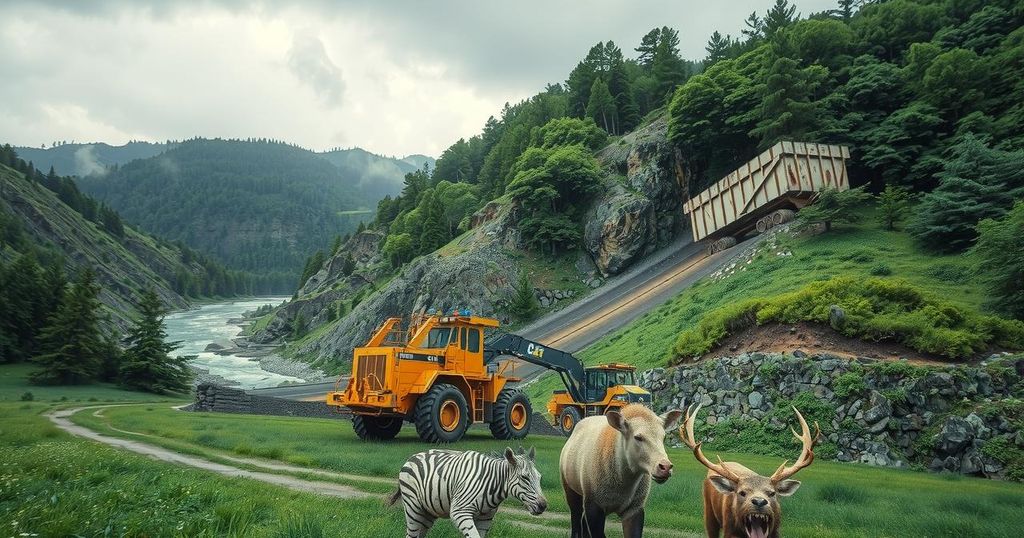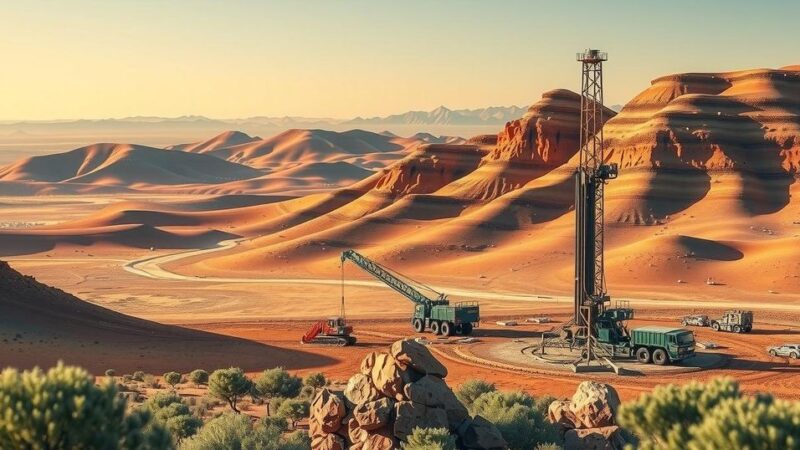The ongoing Chinese mining operations in the Okapi Wildlife Reserve in the DRC are leading to severe environmental destruction, particularly impacting biodiversity and local communities. The reserve’s boundaries were redrawn under questionable circumstances to facilitate mining without adhering to legal protections. As mining continues, poaching has surged, and local livelihoods are jeopardized, reflecting a broader trend of resource exploitation in the DRC.
In the Democratic Republic of Congo’s Ituri province, severe environmental damage is occurring at an alarming rate due to Chinese mining operations, particularly in the Okapi Wildlife Reserve. This UNESCO World Heritage site, known for its rare species, is being compromised as Kimia Mining Investment constructs facilities without adhering to international standards or Congolese laws. The lush forest, which once safeguarded endangered wildlife, has been replaced by an industrial complex, illustrating the unchecked resource extractivism in Africa, even in designated protected areas.
The operations were facilitated by a dubious redrawing of the reserve’s boundaries, which now allow mining activities where they were previously prohibited. Officials characterize this change as occurring under opaque circumstances. While Kimia Mining claims compliance with official maps, the ICCN counters that the original boundaries must be upheld, emphasizing the legal and ethical issues at play.
Beyond the visible impacts of deforestation, alarming practices at Kimia Mining, such as mercury use in gold processing, have been revealed, contaminating local water and soil. The health hazards presented by abandoned mining sites threaten both wildlife and nearby communities, resulting in significant agricultural losses as contamination hampers crop yields.
The Okapi Wildlife Reserve, home to 15% of the global population of okapis, is on the brink of collapse. Escalating mining activities have led to increased poaching, with hunters noticing a sharp decline in game animals. Where the reserve once supported sustainable hunting, it is now largely transformed into an industrial wasteland, threatening local livelihoods.
This situation exemplifies a more extensive issue of Chinese exploitation in the Democratic Republic of Congo. In a separate incident in South Kivu Province, Chinese nationals were apprehended for illegal mining operations. Such unauthorized activities highlight the environmental degradation and socioeconomic impact posed on local communities as they grapple with spiraling poverty due to the loss of traditional livelihoods.
The human cost of these mining operations is significant. As local communities suffer economically, Kimia Mining imposes high charges for access to leftover mining materials, pushing many into financial despair. This trend reflects China’s broader exploitation in the DRC, as seen in the contentious 2008 Sicomines agreement that promised infrastructure development that was inadequately fulfilled, despite extensive mining rights granted to Chinese companies.
Between January and May, over 480 hectares of forest were devastated in the reserve, an area comparable to 900 American football fields. Such loss not only endangers local biodiversity but has wider implications for climate stability, considering the Congo Basin rainforest’s role as a crucial carbon sink. Kimia Mining’s spokesperson revealed a troubling stance, claiming that Congo “cannot place a higher value on the environment than on mining”, underscoring the disregard for ecological conservation.
The Democratic Republic of the Congo (DRC) is rich in natural resources, particularly mineral deposits. However, the exploitation of these resources, often conducted by foreign entities, has worsened environmental degradation and led to significant socioeconomic challenges for local populations. The Okapi Wildlife Reserve, recognized as a UNESCO World Heritage site, is explicitly designated to protect its unique ecological significance and endangered species. Increasingly, mining activities have encroached on these protected areas, raising serious concerns about compliance with legal protections and the long-term consequences for both biodiversity and local communities.
In summary, the aggressive mining operations by Kimia Mining in the Okapi Wildlife Reserve symbolize the critical environmental and social crisis facing the Democratic Republic of the Congo. The degradation of protected lands reflects a broader trend of resource mismanagement, exacerbated by questionable legal practices and a neglect for environmental integrity. The consequences for local communities, biodiversity, and the global climate are profound, necessitating urgent attention and action from both Congolese authorities and international stakeholders to safeguard these invaluable ecosystems and ensure responsible resource management.
Original Source: allafrica.com






